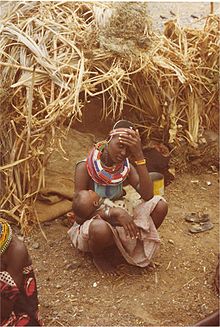El Molo (ethnic group)
The El Molo are a numerically small ethnic group that live in the eastern region of Kenya on the southeastern shore of Lake Turkana .
The original El Molo language , which is one of the Omo-Tana languages within the Kushitic language group , has almost disappeared; it was still spoken by eight people in 1994, while the number of ethnic El Molo in 2007 was estimated at 700. Most El Molo today speak Maa - the language of the allied Samburu - or Turkana .
The traditional name of the El Molo is Gurapau , from gura ("people") and pau ("lake"). El Molo also comes from their language and means "this person" or "he". The Samburu call them Ldes or Ildes ("people from the lake") and the Rendille Dehes , the Turkana Ngimoile or Ngimooloi , the Dassanetch Hereŋ .
According to their own traditions, the El Molo come from the area north of Lake Turkana. They refer to a mountain gulet that they are said to have settled and that is said to be uninhabited today. These traditions agree with the linguistic knowledge that the speakers of Omo-Tana languages spread from the southern Ethiopian highlands.
Traditionally, the El Molo made their living from fishing in Lake Turkana and from hunting, while most of the neighboring ethnic groups live from cattle breeding. When at the end of the 19th century the shepherds lost their flocks due to rinderpest and other epidemics and suffered hunger, numerous impoverished Samburu and some Rendille sought refuge with the El Molo, whose livelihoods were not impaired. They settled with the El Molo and also practiced fishing and hunting until they could return to livestock farming by stealing cattle from the Turkana, the Dassanetch and even from the allied Rendille. Since the Samburu immigrants were far more numerous than the El Molo themselves, the El Molo began to switch to the Samburu language and to adopt cultural elements from the Samburu. These included jewelry, hairstyles, and also boy circumcision , which they had not previously practiced (while clitoral circumcision of girls has always been common). There were mixed marriages that would not have been possible earlier, as the Samburu demanded cattle as the bride price and the El Molo did not keep cattle.
In historical sources, other fishing groups on Lake Turkana - for example a Dassanetch-speaking group living further north on the east bank - are referred to as "El Molo". The first European to encounter the actual El Molo was possibly AH Neumann in 1898.
The El Molo maintain peaceful relations with neighboring peoples, especially since they are a small and militarily weak group, depending on them. The first known attack on them occurred in 1921 when a group of Samburu warriors raided a fishing camp they believed to be a camp of the Borana or a group from Ethiopia . Eight El Molo were killed. The colonial administration ensured that the El Molo received thousands of sheep and goats as compensation from the relevant subgroup of the Samburu. With this they began to keep cattle on a larger scale, whereas before they had only a few head of small cattle to supplement their farming methods. Cattle breeding strengthened her ties with the Samburu. They later also bought cattle.
Europeans often viewed the El Molo as a "dying people" due to their small number and the cultural influence of the Samburu. In 1934 only 84 were counted. The colonial administration, which held a post in Loiyangalani from 1911 to 1915 and then maintained contact with the El Molo through patrols, had sympathy for them as they were considered a threatened people. But while the original language is no longer used and the intermingling with the Samburu continues, the population of the El Molo has grown from 143 in 1958 to 235 in 1976 to around 700 in 2007.
Individual evidence
- ↑ a b ethnologue.com on the El Molo language
- ↑ a b Christine Saiti and Edward L. Lemotou, translated by Wilhelm Meissel: Culture, traditions and everyday life among the El Molos at Lake Turkana, Kenya ( Memento of the original from March 5, 2016 in the Internet Archive ) Info: The archive link was inserted automatically and not yet checked. Please check the original and archive link according to the instructions and then remove this notice. (PDF)
- ↑ a b c d Neal Sobania: Fishermen Herders: Subsistence, Survival and Cultural Change in Northern Kenya , in: The Journal of African History , Vol. 29, No. 1, Special Issue in Honor of Roland Oliver (1988)
- ↑ a b Bernd Heine: Comments on the Elmolo language , in: Afrika und Übersee 59, 1976, pp. 278–299
literature
- Bernd Heine : Traditional fishing in the Rift Valley of Kenya. A linguistic survey , in: Language and History in Africa 4, 1982, pp. 7–40.
